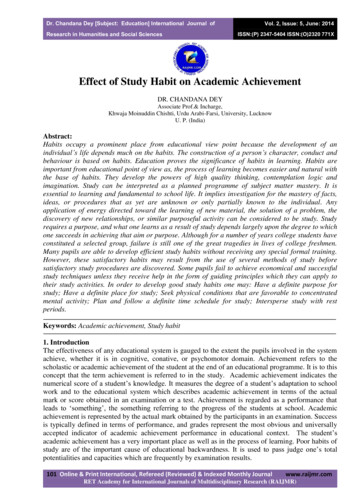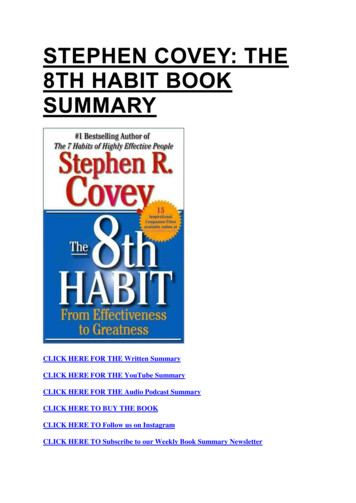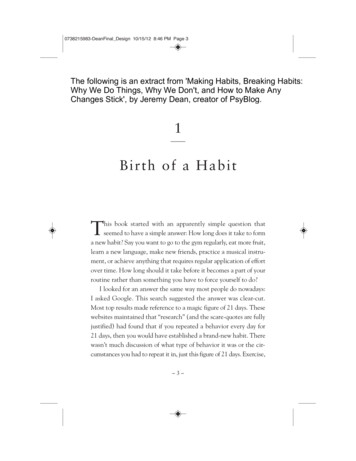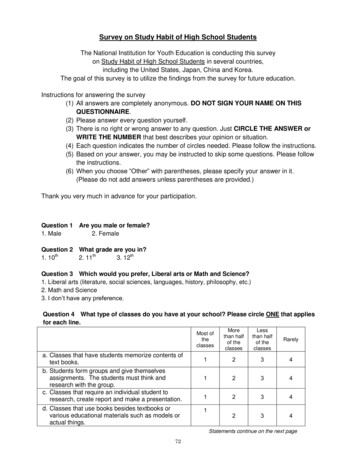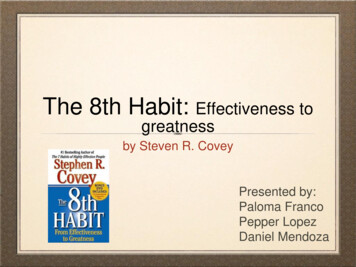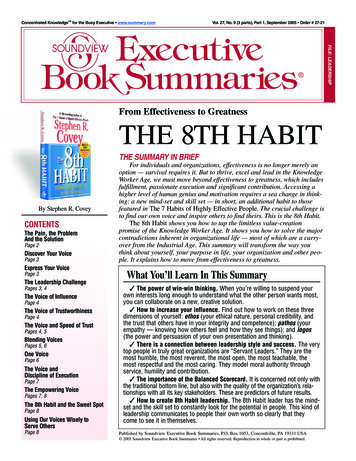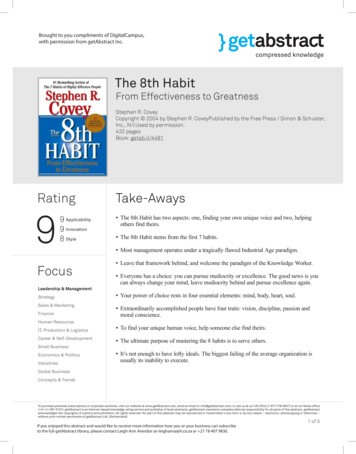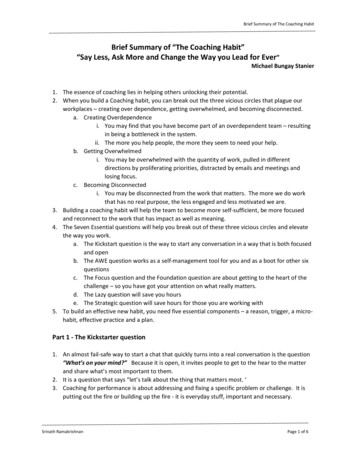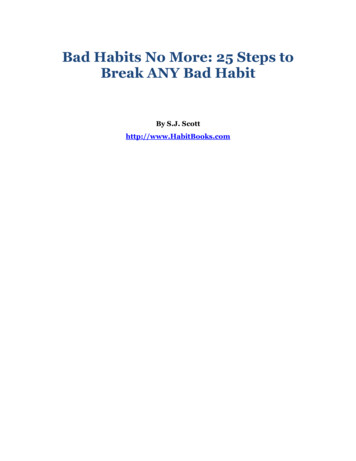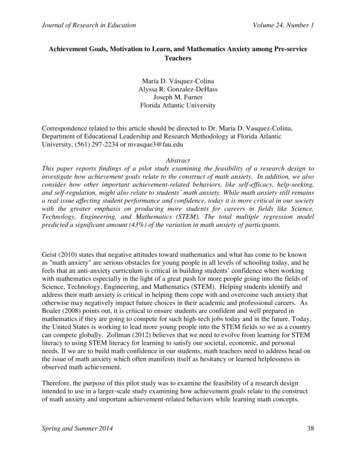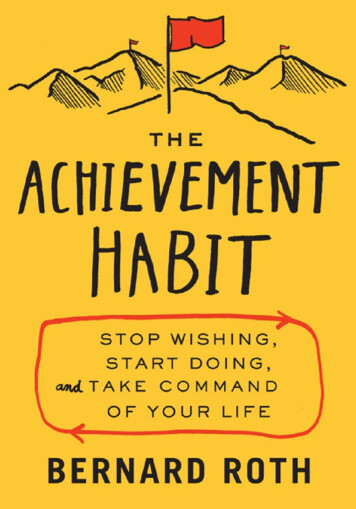
Transcription
DEDICATIONTO THE MEMORY OF ROLFFASTE AND BILL MOGGRIDGE
CONTENTSDedication12345678910Introduction: Yellow-Eyed CatsNothing Is What You Think It IsReasons Are BullshitGetting UnstuckFinding AssistanceDoing Is EverythingWatch Your LanguageGroup HabitsSelf-Image by DesignThe Big PictureMake Achievement Your Habit
AcknowledgmentsNotesBibliographyAbout the AuthorCreditsCopyrightAbout the Publisher
INTRODUCTION:YELLOW-EYED CATSPaddy’s idea wasn’t the most daringin the class.When you first met him, youcould tell he came from a militarybackground. It was evident in hisstance—stoicandsomewhatintimidating. He went to boardingschool in Northern Ireland from ageseven to eighteen and then joined
the Royal Marines, where he servedfor ten years.Civilian life scared him, andafter leaving the military, he quicklysought out the safety net of a jobwithin a large corporation and aregimented schedule. A journalist,he moved around the world quite abit, finding work at places like theBBC and CNBC. “I’m something ofa company man,” he would later tellme.When I met him he was atStanford University on a one-yearfellowshipformidcareerjournalists. He was taking a class ofmine, “The Designer in Society,”
which encourages students toexamine and take control of theirlives. I’ve been a professor ofengineering at Stanford for fifty-twoyears, and along the way I’ve mettoo many engineers who oncedreamed of starting a company oftheir own—and instead ended upworking for large Silicon Valleycompanies and never taking that bigstep toward making their dreams areality. Only a small percentageever followed through on what theyreally wanted to do with their lives,and I hoped to do something tochange that. Having talent and goodideas is only part of the equation.
The next step—the harder step—isthe doing, taking the responsibilityfor designing success in your ownlife.In 1969 I created my “Designerin Society” class as a way toencourage students to thinkdifferently about how they achievegoals in their lives—to get them tostop thinking wistfully aboutpossibilities and start actuallydoing.1 In developing the course, Iemployed principles that we nowcall “design thinking” (a bigconcept we’ll get into a bit later) aswell as a series of ideas andexercises I’ve found to be useful in
assisting people to break throughwalls that are mostly of their ownmaking.At the heart of the course is aself-selected term project: studentsmust either do something they havewanted to do but never done, orhandle something that is a problemin their lives. I am available todiscuss their choices. I emphasizethat it is their project, however, andthat they are doing it for themselves,not for me. Ultimately they decidewhich projects to work on. I don’tdecide whether they’re good enoughor big enough, and I don’t grade onanything other than whether they do
what they set out to do. If theyfinish, they pass. If they don’t, theydon’t get credit.One of the most importantlessons students take away from theclass is to be honest withthemselves—reallydeep-downhonest. The more self-aware youcan become, the happier you can be;by better understanding yourmotivations and identity, you canfigure out how to design your life tobe more satisfying and fulfilling.Paddy dug deep and came to therealization that although he hadthrived in every institution he waspart of, he had never been really
happy. That was in part because hehad a very conflicted relationshipwith authority and the large mediaorganization he belonged to. He hadsought it out because it was what heknew, yet he also resented andrebelled against it because hewanted something more personallysatisfying. Once he realized andacknowledged this fact, he was ableto use that knowledge.For his project, Paddy decidedto produce his own radio show.When he compared his idea toothers’, he wasn’t sure it stacked upvery well. After all, we hadstudents doing things that seemed on
the surface much more exciting (onestudent was going to hurl himselfout of an airplane!), creative(building a rocket), or ambitious(students turning their bodies intomachines to prepare for their firsttriathlons).For Paddy a radio show was amajor undertaking, and it took him awhile to realize why he was sodrawn to it. He had been a radioreporter, but never a producer. Forthe first time in his life he would bemaking something from his ownideas, without oversight. It was adaring choice for him, akin tostarting his own business.
I NOW TEACH MY class at one ofthe world’s leading centers forinnovation, the Hasso PlattnerInstitute of Design at Stanford,commonly called the d.school,where I am the academic directorand one of the founders. It’s gottenpretty famous—the Wall StreetJournal called it “the hottestgraduate program,” and we havemore students signing up for ourclasses than we have seats forthem.2 The d.school is not linked toany particular department butinstead brings together students andfaculty from many disciplines tocreate an environment that fosters
creativity,innovation,andcollaboration.What the d.school does forstudents is open up their worlds,challengingtheir“automatic”thinking and assumptions andshowing them the vast multitude ofpossibilities around them. We writeon whiteboards, Post-it notes, andnapkins. We try things. We fail. Wetry again. We fail better. We getthings right in ways we might neverhave imagined, and we gain a betterunderstanding about ourselves andothers in the process.Many who have taken mycourse over the years credit it with
helping them achieve significantpersonalandprofessionalsuccesses in their lives, and I havegone on to conduct workshopsthroughout the world based on theconcepts taught in the class. It’sempowering to realize you havemore control than you ever knewover what you achieve in life. Whenyou are not happy with an aspect ofyour life, you can change it! Really,you can.In my class students havedesigned and built musicalinstruments, furniture, vehicles, andclothing. They’ve written books,poetry, and music. They’ve flown
and jumped out of various aircraft,done stand-up comedy, and drivenracing cars. They’ve learned how tocook, weld, tend bar, speak newlanguages, and save lives. They’verepaired relationships with parents,siblings, and friends. They’ve runmarathons, lost weight, and bravedthe wilderness.One of the most inspiringprojects I watched unfold was thatof a student named Joel whoreconciled with his father twomonths before his father diedunexpectedly of an aortic aneurysm.Thirty years later I still feel tears ofjoy well up in my eyes whenever I
run into Joel, his wife, or hischildren.The father of another student,Cyndie, had always prohibited herfrom riding a motorcycle becausehe’d suffered a terrible accidentwhen he was younger. Naturally,Cyndie wanted to learn to ride one.She decided to buy a motorcycleand learn to drive it as her project.Several months after my class, Bill,one of her former drawinginstructors, was standing in front ofhis design office in Palo Alto whenshe rode up on her motorcycle andasked if he would like to go for aride. He got on, thinking she meant
around the block. Forty-fiveminutes later they arrived at thebeach. That was twenty-eight yearsago. They now have three grownchildren together.Another woman in my classovercame her fear of water andlearned to swim. I ran into her somemonths later and she told me shewas learning Italian, having feltempowered by her first endeavor inmy class. A few years after that sheearned special training certificatesthat enabled her to change hercareer field—all thanks to themomentum and inspiration gainedfrom developing her achievement
habit.What she and other studentsdemonstrate not only in class butalso in their lives after graduationis that achievement can be learned.It is a muscle, and once you learn toflex it, there’s no end to what youcan accomplish in life.One of my favorite things to dowith a group is to ask people tothink about who stops them fromaccomplishing the things they want.It’s always entertaining to listen tothem explain how their parents,spouses, children, colleagues,bosses—you name it—prevent themfrom reaching their goals. These
perceived obstacles are simplyexcuses; in almost every case, whenyou really dig down, it’s you whoare sabotaging yourself.Yes, sometimes there are realexternal obstacles, and most peopledon’t realize that they have thepower to overcome them. I onceinterviewed a job applicant whotold me of her encounter withpirates when she and her boyfriendwere sailing around the world.While the boat was anchored off thecoast of Indonesia, she wassunbathing while he went into town.Suddenly she heard a noise and sawheavily armed men boarding their
boat. They pointed guns at her anddemanded money. Vulnerable andalone, with no money to give them,she kept her composure and wasable to convince them that thepowdered milk she had on boardwas a worthy replacement for cash.She appealed to their parentalinstincts, knowing milk was hard tocome by and that they probablydesperately needed some for theirchildren. They accepted the milkwith gratitude and left her and theboat unharmed. After hearing herunique solution and admiring herclearheadedness, I hired her on thespot.
That said, most of the time thereare no pirates. We simply stopourselves.To demonstrate this in my class,I ask for a volunteer to come to thefront of the room. When he isstanding in front of me, I hold out awater bottle (or other object) andsay, “Please try to take it away fromme.” The volunteer will tug at thebottle—at first tentatively, becauseI’m older and look weaker, and thenmore forcefully when he realizes Ihave it firmly in my grasp.Eventually I ask the student to stoptrying.I then ask him to listen carefully
to my next instruction. This time Isay, “Please take the bottle fromme.” What follows is essentially thesame action as before, with moreforce and maybe some twistingadded. Sometimes he’ll decide tochange tactics and ask me to hand itover. I always refuse.Finally I ask him, “Do you havea younger sibling or cousin?” I thenask the student to imagine that I amthat person, we’re both kids, andthere are no parents around.Furthermore, I tell him to imaginethe situation has gotten veryannoying, and it is time for him toreclaim the bottle from me. Then I
repeat the instruction, “Take thebottle from me.”Participants who get what I’mdriving at simply whisk the objectout of my hand, leaving me no timeto resist. I am overpowered by theirintention to take the object. Theyhave manifested a dynamic, elegantflow of intention to do, which is insharp contrast to their previousstatic, tentative attempt at doing.Even better, in taking the object theyusually actually exert less forcethan they did before.I use this exercise to show thatwhen you do, you are using power;when you try, you are using force.
In life, if you want to get thingsdone, it is much better to bepowerful than to be forceful.Of course the switch isn’t soeasy to make in real life. We’ve allhad the experience of making up ourminds to do something and then notdoing it—New Year’s resolutions,exercise, fidelity, deadlines, andwork habits being just a fewexamples. In order to make theswitch we must understand ourbehavior. The classic model (andpopular wisdom) says that we thinkthings through first and then act onour thoughts. Interestingly, this doesnot hold up in clinical testing.
By decoding local patterns ofMRI signals in various brainregions, clinicians have shown thatthe brain can send motor signals foractions before the brain consciouslyforms the actual thoughts thataccount for the actions. You dowhat you do, and then you make upthe reason for doing it. Most of ouraction is more the result of habitthan reasoning. So that leads to aquestion: How do you bridge thegap between trying and doing,between talking about somethingand acting on it, and ultimatelybetween failure and success?In this book you’ll find stories,
advice, and exercises designed tohelp you create a differentexperience in your life—experiencebeing the real teacher. When weestablished the d.school at Stanford,we were determined to createexperiences where students dealwith real people, solve realproblems, and make a difference.The results have been hugelygratifying. The students have gaineda sense of purpose, mastery, andintrinsic motivation. A magicalthing happens: the grade is nolonger a useful or meaningfulmotivator. Intrinsic motivation hastaken over, and the work is its own
reward.By the end of the book, as areader you will understand: Why trying is not good enoughand how it is very differentfrom doing. Why excuses, even legitimateones, are self-defeating. How to change your self-imageinto one of a doer and achiever,and why this is important. How subtle language changescanresolveexistentialdilemmas and also barriers toaction. How to build resiliency by
reinforcing what you do (youraction) rather than what youaccomplish, so you can easilyrecoverfromtemporarysetbacks. How to train yourself to ignoredistractions that prevent youfrom achieving your goals. How to be open to learningfrom your own experience andthat of others.The mind is trickier than wethink and is always working withour egos to sabotage our bestintentions. That’s the humancondition. What we have going for
us is that, if we choose to, we canbe mindful about controlling ourintentions to create habits that makeour lives better.The ideas in this book arerooted in the design thinkingtradition. Whereas others haveapplied its tenets in organizationalinnovation and change,3 I havechosen to focus on personaltransformation and empowerment.Stanford’s d.school is a pioneer inthe design thinking movement, andas one of its founders I havewitnessed intense interest from allsectors of education, industry, andgovernment.
A wonderful book called TheAdjusted American, anowsomewhat outdated sociology text,attemp
from developing her achievement. habit. What she and other students demonstrate not only in class but also in their lives after graduation is that achievement can be learned. It is a muscle, and once you learn to flex it, there’s no end to what you can accomplish in life. One of my favorite things to do with a group is to ask people to think about who stops them from accomplishing the things .
